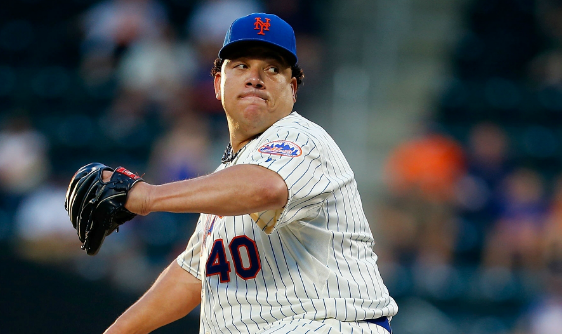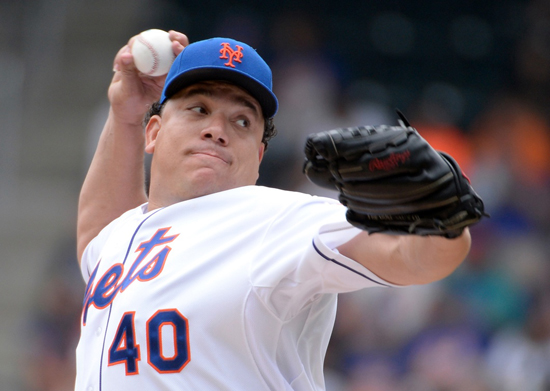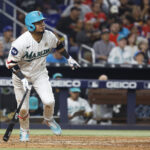
Last year’s free agent class included quite a few short term deals for starting pitchers. Mets GM Sandy Alderson signed 41-year old righthander Bartolo Colon to a two year $20 million deal last winter and the veteran proved to be a durable workhorse who led the Mets this season with 202.1 innings pitched. The deal itself served a purpose and proved useful in 2014, but over the scope of the full two years, it now looks like more of an obstacle, despite the underlying need for insurance within the rotation.
The Mets are built on young power pitching. The rotation of the future may eventually come full circle this year, by that I’m including top prospects Noah Syndergaard and Steven Matz. Couple those two prospects with a font line that includes Zack Wheeler, Jacob deGrom and a healthy Matt Harvey, and the Mets’ best case scenario is a beauty. However when is it reasonable to make decisions based on best case scenarios?
With all the 20-something power arms the team has under control, there’s an element of durability and experience that’s missing from that group of young men. There’s such an intense focus within the Mets community on finding a power hitter while the future of the rotation is being buoyed by lofty assumptions. It’s assumed that Harvey will return without a hitch, but even if he did, the Mets will likely follow an innings limit plan that mimics the program administered for Stephen Strasburg. Jacob deGrom was dominant down the final stretch of the season, but even he served time on the DL with what turned out to be nothing more than fatigue from an increased workload in the majors. Jon Niese and Dillon Gee have been mainstays in the middle of the rotation for several years now, but between their 10 combined seasons (not including rookie years), only three have amounted to more than 185 innings.
If Colon’s purpose was to secure innings around a fragile, inexperienced group, it seems premature to be shopping the remaining year on his contract this winter. The $11 million left on the deal has proven difficult to move off the books, which is understandable considering he’ll be 42 next season. Also, his inaugural season with the Mets wouldn’t necessarily warrant that salary either. Bartolo ended the year with a 4.09 ERA and nearly 1 home run per 9 innings of baseball (0.98), by comparison, his deal may not have been the best fit of all the free agent candidates available.
In hindsight, Phil Hughes‘ performance in 2014, as well as his contract, made much more sense for the Mets in many facets. In his first year out of pinstripes, Hughes revived his once promising career as a Minnesota Twin. He was a better pitcher than Colon and the numbers clearly illustrate this. Compared to 2013 with the Yankees, Phil had 16 wins (+12), 4 losses (-4) and 209 innings pitched (+64) for the Twins this year. The 2014 WAR he posted of 6.1 was fourth best among qualified starting pitchers in the majors. His home run per nine innings rate (HR/9) dropped by 53%, resulting in a more aggressive approach around the strike zone and a massive 73% reduction in walks per nine innings (BB/9).
In reality, all Sandy wanted was a solid innings-eater for half a season, with the understanding that if he wasn’t moved off the books by the All-Star break, it wouldn’t cripple the team’s 2014 season. The gamble in giving Colon that second guaranteed year was banking that the contract could be moved before 2015 when Harvey would finally rejoin the rotation. That has come and gone and now the real hurdle will be executing what is perceived to be the original plan and shop Colon heavily during the winter meetings. The general feeling is that the Mets can retain a balanced mix of hard throwing youngsters and experienced veterans before the remaining prospects are fully developed, but this will put the Mets out of budget to acquire an offensive upgrade. Which brings us to this current conundrum.
A team with as much young talent as the Mets have right now… A team that’s now strong enough to start talking about being a contender… A team like at this given point in its evolution needs a healthy amount of operating room (financial flexibility) to strike when the time is right.
This Mets pitching staff could play out a number of different ways over the next two to three years, but one thing is clear. The Mets now have most of the pieces in place to overcome the final hurdle and vault themselves into contention. But it may also require a willingness to add a high value free agent(s), even if it means a contract in upwards of three years in length.
Does this mean completing the final piece of the puzzle with a round of reckless spending? Of course not. Spending doesn’t always have to be reckless, just ask the Cardinals, Orioles and Giants. Perhaps the missing piece isn’t even out there right now, that’s for the front office to decide. But the point I’m trying to make is that it’s reasonable to expect this level of dedication and commitment from ownership and the front office if in fact this latest 90 win mandate in 2015 has any real backbone or truthfulness to it.
Lets! Go! Mets!
















